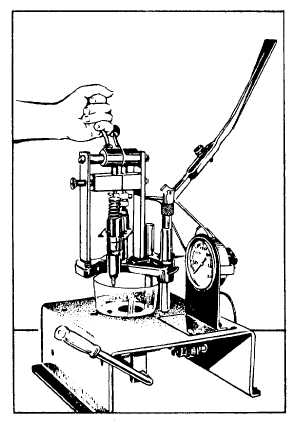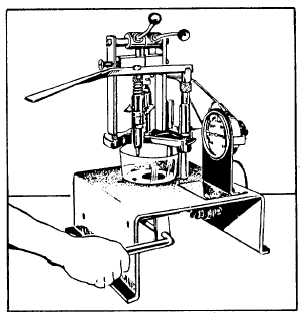Depress the plunger to the bottom of its travel while working the control rack back and forth. If the rack sticks, binds, or fails to move at all, it indicates that the internal parts of the injector are either dirty or damaged.
VALVE OPENING/PRESSURE TEST. - The purpose of this testis to determine the pressure at which the valve opens and injection begins. Place the injector in the tester (fig. 5-28). Operate the pump handle until all air is purged from the injector tester and the injector. Then close the outlet clamp. If you are testing an injector that has just been removed from the engine, the flow of fuel through the injector on the tester should be the same as it was on the engine. If required, reverse the fuel connections on the tester to obtain the proper fuel flow.
With the injector rack in the full-fuel position, pump the handle of the injector tester with smooth, even strokes (fig. 5-29), and record the injector valve opening pressure. The specified valve opening pressure for the crown or high valve injector is 450 to 850 psi. For the needle valve injector, the specified opening pressure is 2,000 to 3,200 psi. If the pressure is not within limits, check the manufacturer's maintenance manuals for probable causes and corrections.

Figure 5-28.-Injector installed in tests.

Figure 5-29.-Checking injector valve opening pressure.
HOLDING PRESSURE TEST. - This test is used to determine whether the various lapped surfaces in the injector are sealing properly.
To conduct this test, bring the pressure up to a point just below the valve opening pressure (450 psi for crown, needle, and high valve injectors). Then close off the fuel shutoff valve. These actions cause the pressure to drop. The time for the pressure to drop from 450 psi to 250 psi must NOT be less than 40 seconds. If the injector pressure drops from 450 psi to 250 psi in less than 40 seconds, dry the injector thoroughly and make the following checks:
1. Open the injector tester fuel valve and operate the pump to maintain the test pressure.
2. Check for a leak at the injector rack opening. A leak indicates a poor bushing-to-body fit.
3. Check for leaks around the spray tip or seal ring. Leaks in these areas are usually caused by a loose injector nut, a damaged seal ring, or a burned surface on the injector nut or spray tip.
4. Check for leaks at the filter cap, which would indicate a loose filter cap gasket.
5. If you find a dribble at the spray tip orifices, it indicates a leaking valve assembly due to either a damaged surface or dirt. Leakage at the tip will cause preignition in the engine.Continue Reading
